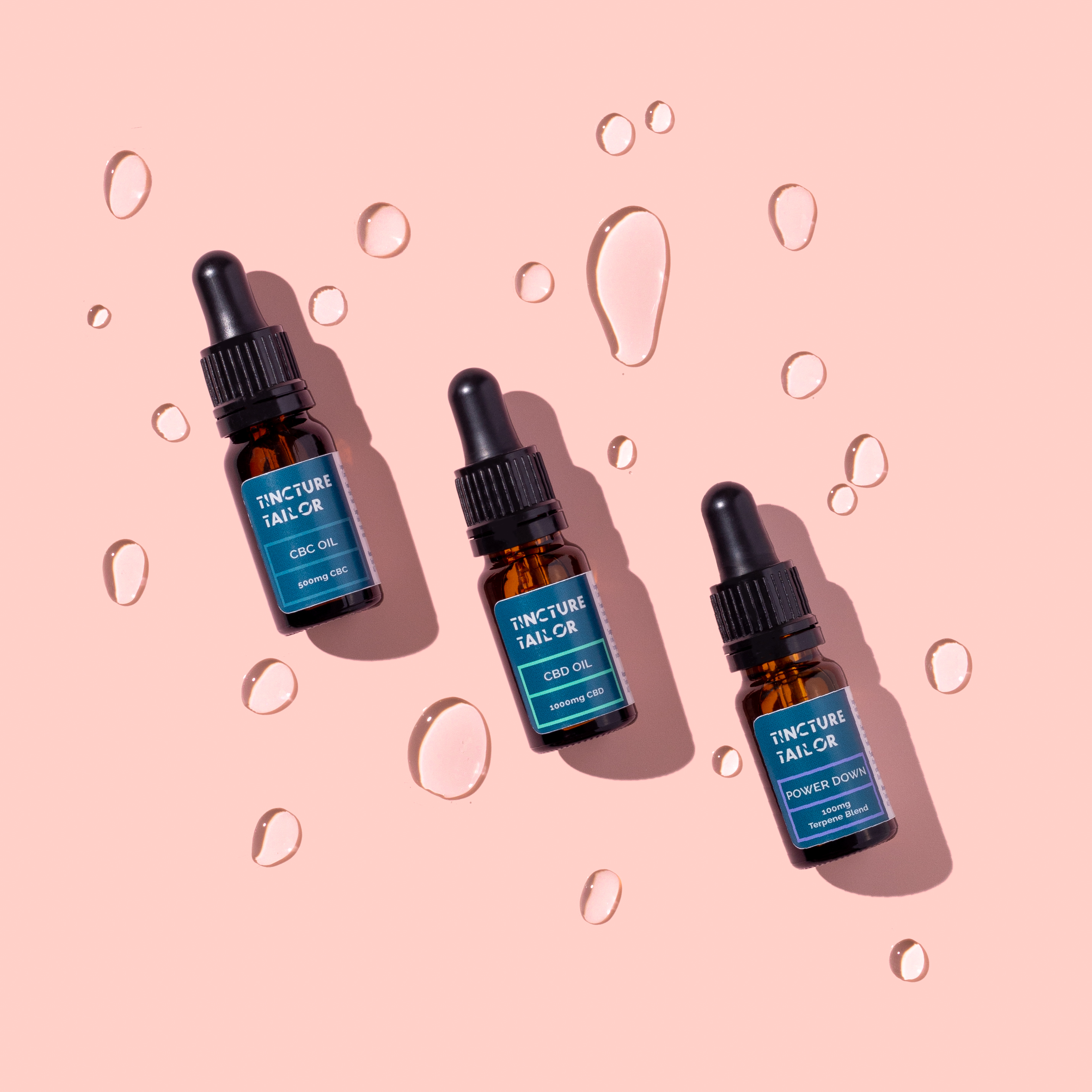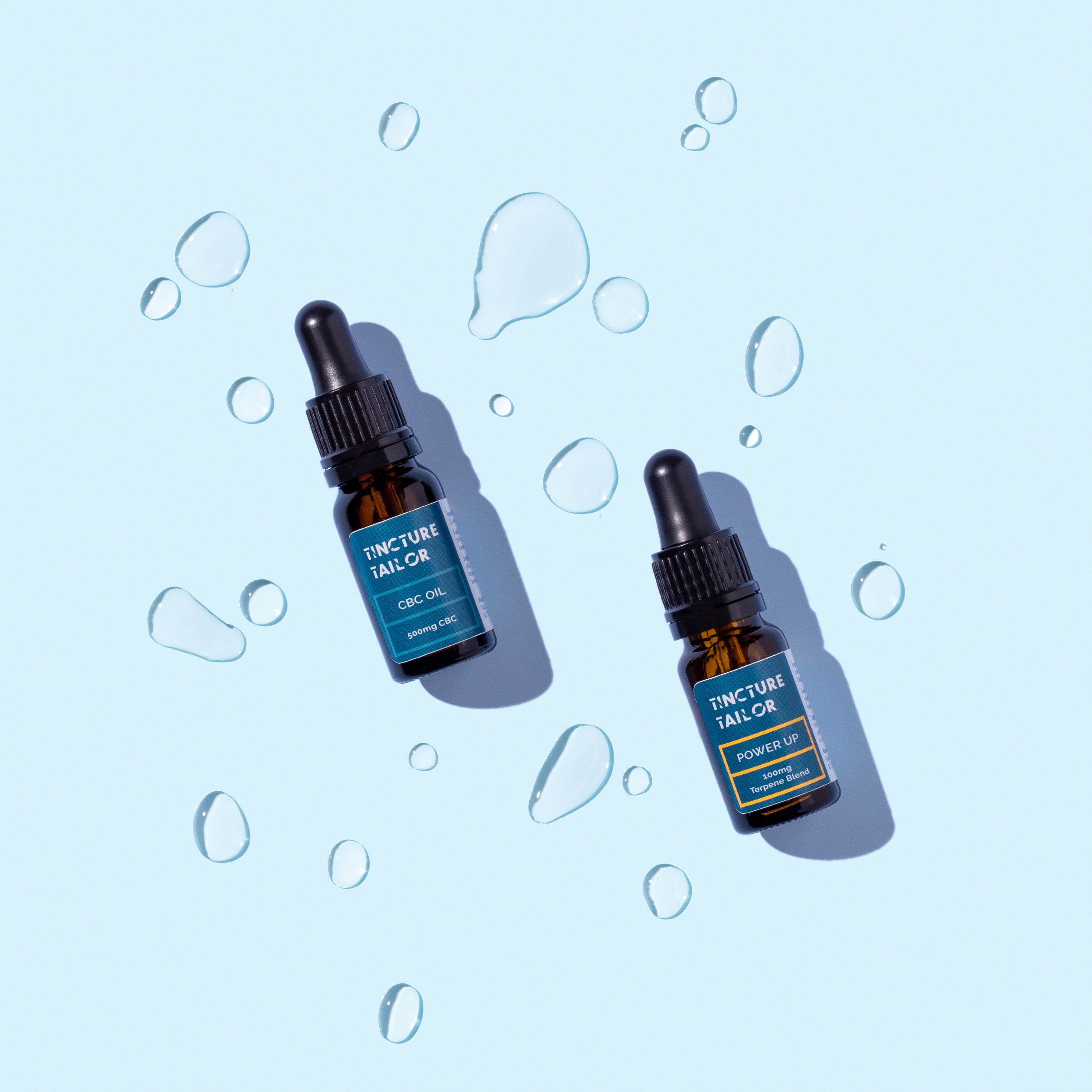Sarah Sinclair, Cannabis health expert and writer explores how Tincture Tailor’s brand new – Cool, Calm Collective package can help with so many common symptoms of the menopause.
- Temperature regulating
- Sleep Support
- Mood Balancing
Bringing together the rebalancing effects of CBD, with the mood-boosting properties of CBC and sleep-inducing terpenes such as myrcene and linalool, the Tincture Tailor Cool, Calm Collective package is designed to help you re-centre and reconnect with your true self. The package includes the brand’s 10% CBD oil, 5% CBC oil and our Power Down tincture to support you in taking a holistic approach to your health and wellbeing.
More and more women report that they are finding CBD helpful for gynecological health, particularly in managing many of the common symptoms of the menopause.
The products which make up the Cool, Calm Collective range have been specifically selected due to their natural ingredients, many of which have been shown to have beneficial effects on sleep, mood, inflammation and generally restoring balance to the body.
Cannabinoids and menopause
Around a third of the UK female population are currently experiencing symptoms of menopause or perimeopause, which last for an average of seven years.
Most of us will be familiar with the ‘hot sweats’ or ‘flushes’ and inability to regulate temperature, which is commonly linked to the menopause. However, it affects everyone differently, with a whole range of symptoms, including low mood, anxiety, depression, insomnia, low libido, poor memory and brain fog.
CBD directly interacts with the endocannabinoid system (ECS) which is responsible for maintaining homeostasis – or balance – in the body, binding with CB1 receptors which are found in many parts but mainly the central nervous system. Through this interaction it can have a beneficial effect on inflammation, mood stability and sleep, all of which may be disrupted during the process of menopause. [1] [2] Furthermore, it interacts with the serotonin and opioid receptors which help to regulate pain, sleep and mood.
CBD may also be useful for promoting bone health. During menopause the body’s estrogen levels drop, which according to the National Osteoporosis Foundation (NOF) speeds up bone loss and increases the risk of osteoporosis.
Some early animal studies suggest that CBD may promote bone healing by activating the cannabinoid receptors [3] and a review from 2020 also found that endocannabinoid activity protects against bone loss [4] although further clinical trials are still needed to validate these claims.
CBC
CBC, or Cannabichromene, is another non-intoxicating cannabinoid found in the cannabis plant. It is found in lesser amounts to CBD and THC and works in a different way to them in the body. Don’t let this put you off though – it still boasts a wealth of therapeutic properties and can even enhance the effects of the two better-known cannabinoids.
CBC binds to the vanilloid receptor 1 (TRPV1) and transient receptor potential ankyrin 1 (TRPA1) receptor channels in the body, which are responsible for regulating inflammation, temperature and brain health.
There is also growing interest in the use of CBC as a tool for managing stress and depression. In a 2010 study, animals performed better on stress tests after being administered CBC. [5]
When combined with THC and CBD, it is thought that CBC may deliver mood-boosting properties and could play a part in helping to shake off sluggishness and improve focus in those struggling with brain fog, which can be a common symptom of menopause.
Terpenes
While CBD and CBC can be beneficial alone, evidence is showing that the entourage effect plays an important role in achieving the best results from cannabis-based products. [6] This is the theory that the effects of all the compounds of the plant together is greater than the effect of any individually.
Tincture Tailor’s Power Down terpene blend is designed to be taken alongside your daily dose of cannabinoids to boost their potential.
Mycrene
Mycrene is the most prevalent terpene found in cannabis and can be identified by its peppery scent also present in plants such as lemongrass, thyme and hops.
Mycrene has a long history of use as a sleep aid in herbal medicines, unsurprisingly, as studies show it can act as sedative and muscle-relaxant [7] making it a natural go-to for those experiencing insomnia.
Linalool
Likewise, Linalool, which is easily recognised by the soothing scent found in lavender and chamomile, is also thought to boast stress-relieving and sedative effects.
Anecdotal evidence suggests that linanool can help with anxiety, depression and insomnia.
Meanwhile more robust studies have found that it could help ease sleeping problems [8] and reduce inflammation[9].
In one paper, lab rats were given linalool to inhale, whilst being exposed to stressful conditions, with the authors reporting that the terpene returned elevated stress levels in the immune system to near-normal levels. [10]
Bisabolol & Nerolidol
The Power Down blend also contains Bisabolol, which is extracted from German chamomile and thought to be a relaxant, and Nerolidol, which is produced naturally by plants such as ginger, jasmine, lavender, lemongrass and tea tree as well as Cannabis sativa. Nerolidol is a natural protectant against insects.
In a 2011 paper, renowned cannabis scientist, Ethan Russo – who famously linked hard to treat conditions such as fibromyalgia, migraine and IBS to a deficiency in the ECS – wrote about nerolidol as having proven sedative properties. [11]
How to use the Cool Calm Collective range
It is never one-size fits all when it comes to cannabis. Tincture Tailor is all about finding the right products to suit your individual needs. Start by taking a few drops of each tincture daily, gradually increasing your dose according to your body and your desired effects.
While more evidence is needed to further examine the effect that cannabinoids can have on hormone regulation and the symptoms of menopause. However, what we do know is that by using cannabinoids and terpenes in combination with each other, you are allowing the plant to work to its optimal potential – through the entourage effect – to restore the body’s natural balance, supporting sleep, mood stability and overall well-being.
References
1 – Barrie, N., & Manolios, N. (2017). The endocannabinoid system in pain and inflammation: Its relevance to rheumatic disease. European journal of rheumatology, 4(3), 210–218. https://doi.org/10.5152/eurjrheum.2017.17025
2 – Kesner AJ and Lovinger DM (2020) Cannabinoids, Endocannabinoids and Sleep. Front. Mol. Neurosci. 13:125. doi: 10.3389/fnmol.2020.00125
3 – O’Connor, C. M., Anoushiravani, A. A., Adams, C., Young, J. R., Richardson, K., & Rosenbaum, A. J. (2020). Cannabinoid Use in Musculoskeletal Illness: a Review of the Current Evidence. Current reviews in musculoskeletal medicine, 13(4), 379–384. https://doi.org/10.1007/s12178-020-09635-x
4 – Raphael-Mizrahi, B., & Gabet, Y. (2020). The Cannabinoids Effect on Bone Formation and Bone Healing. Current osteoporosis reports, 18(5), 433–438. https://doi.org/10.1007/s11914-020-00607-1
5 – El-Alfy, A. T., Ivey, K., Robinson, K., Ahmed, S., Radwan, M., Slade, D., Khan, I., ElSohly, M., & Ross, S. (2010). Antidepressant-like effect of delta9-tetrahydrocannabinol and other cannabinoids isolated from Cannabis sativa L. Pharmacology, biochemistry, and behavior, 95(4), 434–442. https://doi.org/10.1016/j.pbb.2010.03.004
6 – Ferber, S. G., Namdar, D., Hen-Shoval, D., Eger, G., Koltai, H., Shoval, G., Shbiro, L., & Weller, A. (2020). The “Entourage Effect”: Terpenes Coupled with Cannabinoids for the Treatment of Mood Disorders and Anxiety Disorders. Current neuropharmacology, 18(2), 87–96. https://doi.org/10.2174/1570159X17666190903103923
7 – do Vale, T. G., Furtado, E. C., Santos, J. G., Jr, & Viana, G. S. (2002). Central effects of citral, myrcene and limonene, constituents of essential oil chemotypes from Lippia alba (Mill.) n.e. Brown. Phytomedicine : international journal of phytotherapy and phytopharmacology, 9(8), 709–714. https://doi.org/10.1078/094471102321621304
8 – Takeda, A., Watanuki, E., & Koyama, S. (2017). Effects of Inhalation Aromatherapy on Symptoms of Sleep Disturbance in the Elderly with Dementia. Evidence-based complementary and alternative medicine : eCAM, 2017, 1902807. https://doi.org/10.1155/2017/1902807
9 – Peana, A. T., D’Aquila, P. S., Panin, F., Serra, G., Pippia, P., & Moretti, M. D. (2002). Anti-inflammatory activity of linalool and linalyl acetate constituents of essential oils. Phytomedicine : international journal of phytotherapy and phytopharmacology, 9(8), 721–726. https://doi.org/10.1078/094471102321621322
10 – Akio Nakamura, Satoshi Fujiwara, Ichiro Matsumoto, and Keiko Abe
Journal of Agricultural and Food Chemistry 2009 57 (12), 5480-5485
DOI: 10.1021/jf900420g
11 – Russo E. B. (2011). Taming THC: potential cannabis synergy and phytocannabinoid-terpenoid entourage effects. British journal of pharmacology, 163(7), 1344–1364. https://doi.org/10.1111/j.1476-5381.2011.01238.x







Thanks!